
The Aarhus School of Architecture was founded in 1965 in Aarhus, Denmark. Along with the Royal Danish Academy of Fine Arts, School of Architecture in Copenhagen, it is responsible for the education of architects in Denmark. The school has approximately 750 students.

Business- and Agricultural Bank of Jutland is a listed building and a former Danish bank in Aarhus.

Aarhus Old City Hall is the former city hall of Aarhus, Denmark, and a listed building. The city hall was built in 1857 and was listed in the Danish national registry of protected buildings and places by the Danish Heritage Agency on 18 March 1996. It is the second, and oldest preserved, city hall of Aarhus.
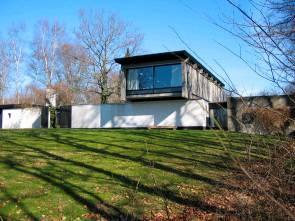
Højen 13 is a villa and listed building in Aarhus, Denmark. The villa was built in 1958 and was listed in the Danish registry of protected buildings and places by the Danish Heritage Agency on 11 January 2008. The house was built by the architect Knud Friis as his home and study on a hill overlooking Brabrand Lake in the Brabrand suburb.

Stykgodspakhuset, or Pakhus 13, is a former warehouse and a listed building in Aarhus, Denmark. The warehouse was built in 1926 and was listed in the Danish national registry of protected buildings and places by the Danish Heritage Agency on 4 April 2006. The warehouse is situated on the water front of the Port of Aarhus in the central Indre by neighbourhood next to the Custom House and has functioned as a storehouse for parcels and other small cargo since completion to the mid 20th century. The building is today used for offices after extensive renovation in 2007.
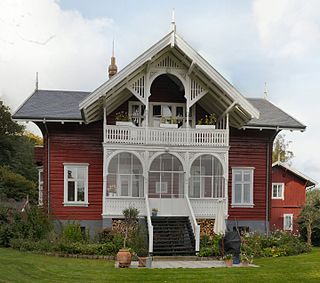
Det Norske Hus is a listed building in Aarhus, Denmark. The house was first built in 1888 and it was listed in the Danish national registry of protected buildings and places by the Danish Heritage Agency on 14 October 1996. The house is situated on the northern border of Riis Skov in the northern neighbourhood Risskov. The building is today privately owned and used as a home.

Aarhus Craftsmen's Association's Asylum is a listed building and a former asylum in Aarhus, Denmark. The building was finished in 1866 and was listed in the Danish national registry of protected buildings and places by the Danish Heritage Agency on 27 September 1980. The building is situated on Paradisgade in the central Indre by neighbourhood.
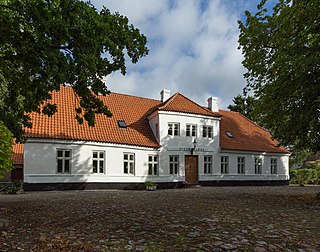
Jarlsminde is a farm and a listed building in Aarhus, Denmark. The farm was built in 1798 and was listed in the Danish national registry of protected buildings and places by the Danish Heritage Agency on 3 June 1997. The farm is situated in the suburb Stavtrup about 7-8 km. south-west of the city centre of Aarhus where it sits on a hill with a view of Brabrand Lake and the large urban areas on the other side of it.

Mejlen or Asylet Børnely is a house, former asylum and a listed building in Aarhus, Denmark. The house was built in 1768 and was listed in the national Danish registry of protected buildings and places by the Danish Heritage Agency on 8 November 2008. The building originally functioned as a kindergarten but is today home to an art gallery.
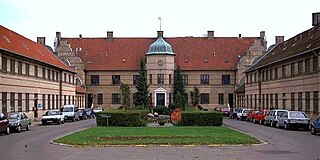
Jydske Asyl is a listed building in Aarhus, Denmark constructed in 1850 and listed in the national Danish registry of protected buildings and places by the Danish Heritage Agency on 15 December 1997. It was built as a psychiatric hospital and functioned as such till the end of 2018.

Vester Allé 12 is a listed building in Aarhus, Denmark. The building was completed in 1902 and was listed by the Danish Heritage Agency in the Danish registry of protected buildings and places on 5 April 1988. The building is situated on the west side of Vester Allé close by Vester Allé Barracks and ARoS Aarhus Art Museum. The building has been home to some of the earliest cultural institutions in the city.
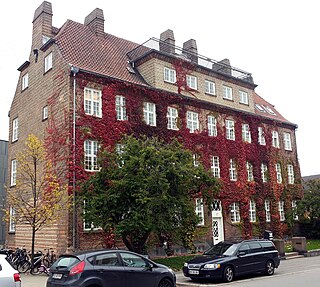
The Baumann House is a listed building in Aarhus, Denmark. The building was constructed in 1911 and was listed in the national Danish registry of protected buildings and places by the Danish Heritage Agency on 18 September 1996. The building is situated in the central Indre By neighborhood on Jægergårdsgade adjacent to the Aarhus Central Workshops.

Juul's House is a house and a listed building in Aarhus, Denmark. The house was built in 1629 and was listed on the national Danish registry of protected buildings and places by the Danish Heritage Agency on 1 April 1984. The building is one of the oldest in the city and it is situated in the historical Latin Quarter on Mejlgade. It has been a paint shop since 1842 and it is the oldest paint shop in the country.
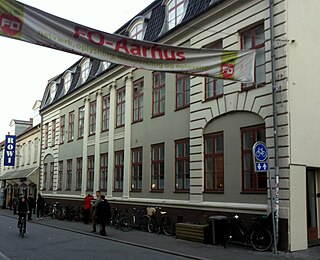
Herskind's House is a house and a listed building in Aarhus, Denmark. The house was built in approximately 1850 and was listed on the Danish registry of protected buildings and places by the Danish Heritage Agency on 2 October 1970. The house is situated in the historic Indre by neighborhood on Frederiksgade, close to the City Hall.

Hans Broge's House is a house and a listed building in Aarhus, Denmark. The house was built in 1850 and was listed on the Danish registry of protected buildings and places by the Danish Heritage Agency on 6 September 1987. The house is situated in the historic Indre by neighborhood on Mindegade close to the harbor and the Port of Aarhus.

Thorup's Kælder is a listed structure and a bar in Aarhus, Denmark. It is a basement built approximately 1300 by Cistercian monks. The basement was listed on the Danish registry of protected buildings and places by the Danish Heritage Agency on 1 January 1959. The listing is officially "Den Grå Kannikegård" which refers to the entirety of the building at the address although only the basement beneath it is protected. The structure is situated in the historic Latin Quarter neighbourhood on Store Torv adjacent to the Cathedral.

Mejlgade is a street in Aarhus which runs north to south from Østbanetorvet to Skolegade and intersects Nørrebrogade. The street is situated in the historic Latin Quarter neighborhood and has the highest number of historic and listed buildings in the city. Mejlgade is one-way and no-parking zone for cars for most of its length and pedestrians and cyclists are given priority. The single lane is tiled and a part of the Cykelringen bicycle ring which circumnavigates the city center. Mejlgade has a high number of small specialty shops and some cafés and bars.

Christian Frühstück Nielsen was a Danish architect born in Aarhus, Denmark on 7 August 1878. Frühstück Nielsen primarily worked in and around Aarhus and on Mors where he left numerous lasting works.

Aarhus County Hospital, or Aarhus Sygehus, Tage-Hansens Gade, was a hospital in Aarhus for 136 years, from 1882 to 2018. The hospital became a part of Aarhus University Hospital in 2011 in an administrative merger. In 2018, all hospital functions at Aarhus County Hospital were relocated to The New University Hospital (DNU) in Skejby in northern Aarhus.

The architecture of Aarhus comprises numerous architectural styles and works from the Middle Ages to present-day. Aarhus has a well-preserved medieval city center with the oldest dwellings dating back to the mid-1500s and some ecclesiastical structures such as St. Clemen's Cathedral and numerous smaller churches that can be traced back to the 1100s. The industrialization of the 19th and 20th centuries left distinctive industrial structures, important National romantic works and some of the best examples of Functionalist architecture in the country. The history of the city as a Viking fort is evidenced in the street layout of the Latin Quarter, the wider Indre By neighborhood testifies to its later role as a Market town and center of commerce while the Frederiksbjerg, Trøjborg and Marselisborg districts showcase the first cohesive urban planning efforts of the early 20th century.




























